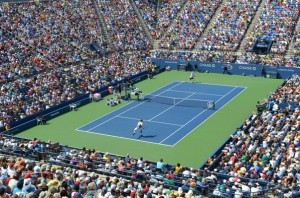By Romi Cvitkovic
Each year, American tennis fans congregate in Flushing Meadows to watch their favorite players, rising stars and living legends compete in the annual U.S. Open.
Ticket prices for single sessions range anywhere from upwards of $1000 for the second week, to $64 for grounds passes the first week. With record-breaking crowds and sold out sessions, fans aren’t afraid to flaunt their money at the USTA, the governing body of the U.S. Open, in order to see their favorite players. But at what cost to the athletes?
A recent topic of debate has been equal prize money between the men’s and women’s tours at Slams. But there is another, and perhaps greater, disparity in prize money and that is between governing tennis associations and the players themselves.
During the first eight days of the U.S. Open, around 16,000 grounds passes are sold daily in addition to the 46,000 tickets for both the day and night sessions in Arthur Ashe stadium, and the 1500 or so additional reserved seats in Louis Armstrong stadium.

Grounds pass holders, with access to all courts except Ashe, filled the Armstrong and Grandstand stadiums to capacity all day Sunday as they watched the likes of defending champion Sam Stosur, 2009 US Open champion Juan Martin del Potro and 2011 Wimbledon champion Petra Kvitova play.
Breaking it down, the two women’s matches last Sunday included three players in the top 11 of world rankings, while the four men’s matches featured five players in the top 20. To see this much great tennis for just $64 for a fan is a steal.
But as grounds passes alone bring in just over $1 million daily to the USTA for those first eight days, there must be some healthy payouts for the players, or rather, losers those eight days as well, right?
Not so fast.
If you were a player that lost on Armstrong or Grandstand in the third round for men or fourth round for women, you would have received $65,000 and $120,000, respectively. That’s a combined $500,000 payout from the $1 million they made for the USTA by just playing. And that’s pretty much the payout cap during days that offer grounds passes, as players who lost in earlier rounds make only $23,000 or $37,000 each.
Not sold on the financial disparity between the USTA and tennis players yet? Consider this.
If we priced the 46,000 Ashe tickets at $150 each – considerably lower than the cost of lower bowl seats but taking into account not all sessions sold out – for the duration of the tournament of roughly 13 days, then the USTA makes about $90 million. Add to that suppliers and sponsors, and broadcasting companies for another $60 million each, and you have the USTA making a mouth-watering $218 million for a two week event – and that’s not even taking into account food, beverage and merchandise sales.
Of the $37 million in prize money available for singles in both the ATP and WTA Tours, players receive a mere 8.6% in revenues from the U.S. Open’s $218 million. Compare that to NFL players receiving 47% of revenue and NBA players receiving 51% of revenue, and we have a real issue on our hands. And this isn’t exclusive to the U.S. Open either, as Wimbledon, Roland Garros and the Australian Open face the same troubles, and weary players threatening to strike.
If the Slams were to decide to increase their prize money, they shouldn’t look to the BNP Paribas Open as an example. In March, owner Larry Ellison twisted the hand of the ATP Tour by feeding in an additional $1.7 million in prize money to the 2012 tournament, but stipulated that $389,000 go into increasing the winner’s paycheck to $1 million while another $700,000 go into the final three rounds only. While the winner received a 64% increase, the first-round losers received only a 8% increase.
As it stands, the 128-player singles draws at the Slams carry a heavy disparity in prize money as the top four finishers receive a combined $3.8 million, or 20% of the prize money. While there is only one male and female winner at the end of the event, fans attend all two weeks to see all the players – not just the championship matches. Rewards to players should reflect that.
Instead of giving players prize money solely based on what round they lost, how about including bonus payouts based on the number of sets won, or some other statistical method that is sure to promote competition and fan interaction?
For a sport with such international reach in terms of fans, players and tournament, prize money disparity should really not be an issue.
